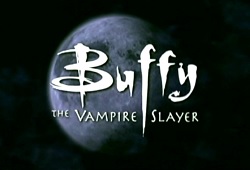
Buffy the Vampire Slayer may have ended its seven-year, 144-episode run on May 20, 2003, but the show’s popularity never truly waned. Originally crafted as a metaphor for the horrors of high school, it morphed into a coming-of-age narrative as the series progressed. Although Buffy was primarily a drama, it could also be funnier than any comedy on television – an amalgamation of numerous genres, expertly blended, adding to its vast appeal.
During its sixth season, the term “musical” was added to the list with the critically-acclaimed episode “Once More With Feeling.” Instead of being a one-shot hour of television, however, the installment briefly blossomed into a cultural phenomenon when Buffy Sing-Alongs started popping up shortly after the television series ended. These special screenings of “Once More With Feeling” packed theaters across the country over a three year period, bringing together Buffy fans and musical aficionados for a night of interactive entertainment.
Buffy Sing-Along initially sprouted organically. Instead of FOX or Mutant Enemy – the two production companies involved with show – marketing it to outside venues, it was the venues themselves that took the lead in securing the licensing rights and organizing the showings. The Coolidge Corner Theater in Brookline, Massachusetts, has the distinction of holding the first Sing-Along on October 22, 2004, with the Alamo Drafthouse in Austin, Texas, following two months later. Vancouver added its name to the list in 2005, and during a two-week period in September 2006, New York City and Pittsburgh also joined the fray.
Because these Buffy Sing-Alongs were fan-driven without any formalized structure, each location was free to give the event its own unique flavor. The Alamo in Austin – which held over seven Sing-Alongs – often screened a “warm-up” episode of Buffy the Vampire Slayer before the main event. New York City had a Buffy-oke contest, meanwhile, and offered attendees the opportunity to act out scenes from the series, while Pittsburgh had a trivia contest “showdown” between two lucky fans of the show.
Despite such innovation, other aspects of these Buffy Sing-Alongs did indeed overlap. “Goody bags” were given out, containing everything from plastic fangs to kazoos, bubble blowers to packets of mustard. Fliers were also made available so that audience members would know when to use each item – the bubbles were for Willow and Tara’s “Under Your Spell,” for instance, while everyone was asked to hum on the kazoo during “Something to Sing About.”
Attendees were also encouraged to dance in the aisles during “I’ll Never Tell,” as well as hold hands and sway for “Where Do We Go From Here?” Vancouver even passed out underwear for people to throw during “The Parking Ticket” song, which contains the line, “Hey, I’m not wearing underwear.”
“If Star Trek had done a musical episode, we would all be here on a Friday night,” remarked Elizabeth Cromwell, one of the hundreds of Buffy the Vampire Slayer fans who attended the September 2006 screening in Pittsburgh, Pennsylvania. “If The X-Files had done a musical episode we would be here, but they never did. There is nothing else. The kind of shows that hit on this level are few. Rocky Horror was first. Maybe this Buffy is second.”
Cromwell was not the only one to draw similarities between “Once More With Feeling” and The Rocky Horror Picture Show, as the IFC Center in New York City billed the Buffy Sing-Along as being “in the tradition of Rocky Horror.”
“Who doesn’t dream of getting a little piece of that vibe?” Buffy creator Joss Whedon rhetorically asked MTV at the time. “I wrote it to be an episode of television to air and disappear. I didn’t think about its afterlife that much, and now it has much more of an afterlife than I could ever have expected, and a much more fun one.”
Clinton McClung, a consultant for the IFC Center, eventually emerged as one of the major spearheads of the Buffy Sing-Along movement, not only organizing events in New York City but traveling across the country as well. “We did one weekend a month at the IFC Center for almost a year, and played 22 weekends in other cities,” he explained to BuffyFest in 2008. “In total, we had over 16,000 attendees.”
Just as McClung’s efforts – as well as a multitude of others across the country – began to pick up steam, FOX pulled the plug. Although organizers of the Buffy Sing-Alongs were not getting rich from their efforts, they were charging admission to each event, which eventually caught the eye of the Screen Actors Guild. When FOX was presented with a six-figure bill for unpaid actor residuals in 2007, cease-and-desist orders were immediately sent out.
“That was never part of the license agreement,” FOX spokesman Chris Alexander told MTV regarding the arrangement between the production company and distributer Criterion. “Their license agreement was to show it in certain arenas where admission is not charged, like on airplanes, in churches, on Army bases, but not commercial theaters. So they went beyond what they were authorized to do.”
The Buffy Sing-Alongs may have ended in 2007 but – to paraphrase another classic musical – for one brief, shining moment they were part of the pop culture landscape nonetheless, from Boston to Austin, Pittsburgh to San Francisco, and an untold number of places in between.
Anthony Letizia

